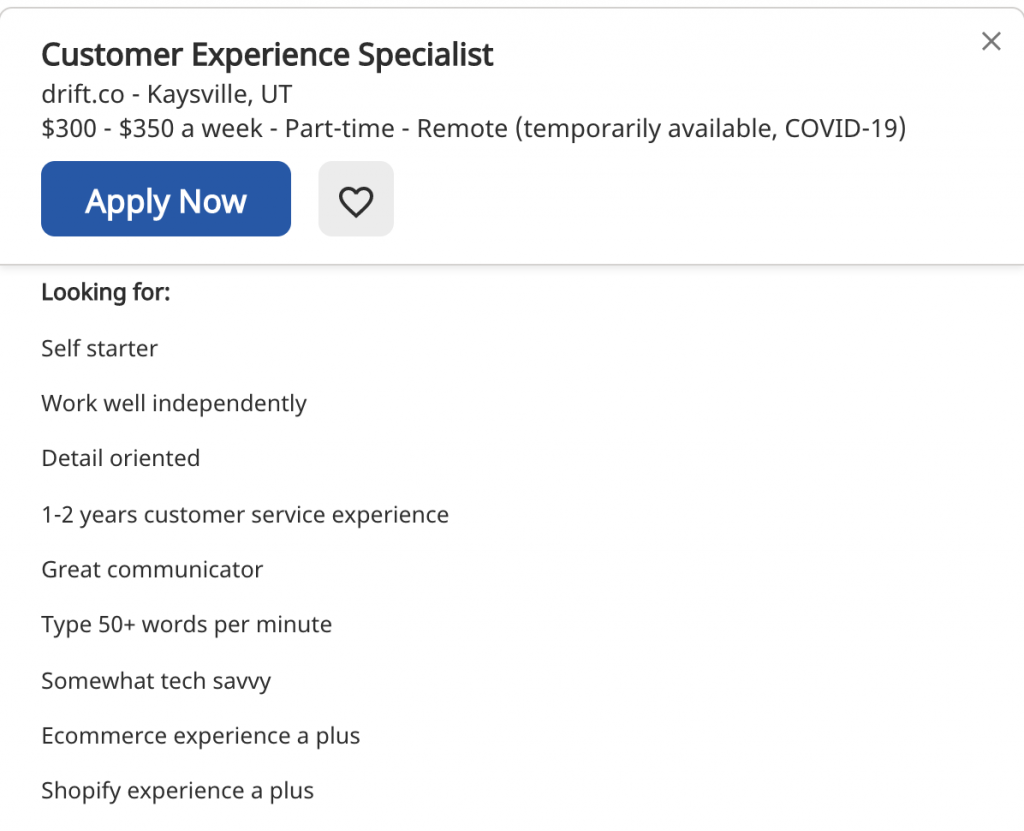The 9 Steps of How to Interview and Hire Remotely
01 May 2020 By: Jessica Wise
Updated
From online interviews to working from home from the start. This is what employers need to know.
Even under traditional circumstances, interviewing and hiring can be a rigorous process. But, in an increasingly digital world, many management teams have decided to go virtual.
Unfortunately, this doesn’t change the fact that there are still resumes to comb through, background checks to run, references to follow up with, work history to verify, portfolios to review, and interviews to schedule.
And, don’t forget that your team will have to formulate an effective plan to successfully complete virtual onboarding and training.
I know…so far I am making it sound like vetting a remote job candidate is an extreme sport.
But, it kind of is, and if it doesn’t feel that way, it should.
A new employee is a huge investment. Hiring an employee in a company with 500 employees or less costs an average of $7,645. (biz30)
Hiring an employee in a company with 500 employees or less costs an average of $7,645. Share on XSo, it’s critical to ensure that your efforts aren’t wasted on the wrong candidate.
However, when you don’t have the chance to meet a future employee in-person, it takes extra effort and a bit of creativity to guarantee that he or she is the right fit for the job.
Here are the 9 steps of how to interview and hire remotely.
Post a Clear, Transparent Job Description
Ambiguous job postings are a huge issue for many jobseekers.
72% of hiring managers say they provide clear job descriptions, while only 36% of candidates feel the job description is in fact clear. (G2.com)
72% of hiring managers say they provide clear job descriptions, while only 36% of candidates feel the job description is in fact clear. @G2dotcom Share on XAnd, because the work will be remote, it’s all the more important to spell out exactly what you expect.
“I’ve managed remote employees for multiple companies, and the key is a clear job description and expectations,”
states Rolf Gehrung of AccuZip. (Jive)
Be sure to state that your company’s remote opportunity will require the same level of commitment and dedication as any on-site role.
Also, be specific about the qualities you value in a remote candidate. And, don’t be afraid to be overly detailed. That way there will be no surprises for either party.
This job posting from drift.co is a great example.

Request Writing Samples
If you’re going to interview and hire remotely, you should know that 73% of employers seek out candidates that have a strong writing ability. (Inc)
73% of employers seek out candidates that have a strong writing ability. @Inc Share on XIt’s easy to understand why. Many of the top apps used by today’s workforce (i.e. Slack, Google Hangouts, What’s App, and Gmail) center around written communication.
Plus, when your team doesn’t have the luxury of working under the same roof, above average communication skills are critical.
So, don’t hesitate to ask for writing samples.
Pro tip: You can also test candidates typing, grammar and spelling skills in advance by using HelpSquad’s free virtual Live Chat Challenge test.
Remotely hiring? Test out your candidates skills using our Live Chat Challenge: https://t.co/CVKKJFRKl2#thingstodoinlockdown #coronavirus #remoteworking
— HelpSquad (@helpsquadusa) April 29, 2020
Ensure Your Candidates Are Technologically Savvy
Consider the daily responsibilities associated with your job opening and the required level of technological savvy.
Then, find out if the applicants have experience using the needed hardware and software.
For instance, if processing and filing paperwork is part of the job description, does the candidate know how to scan a document and save it to a laptop as a PDF?
Does the candidate have an understanding of standard software programs like Microsoft Office Suite and Adobe Acrobat?
Of course, anyone can say they possess these skills.
But, how will you know for sure?
“Create a time constrained task or project that’s relevant to the work they would be doing in the position,” recommends remote job board, WeWorkRemotely in their “Guide to Hiring Remote.”
6 years of growing with ‘the remote work phenomenon’ + 2.5 months of research and writing feverishly have led to the birth of our new hiring guide. 🤗
Learn what you need to know about sourcing, interviewing, and hiring top remote candidates:https://t.co/OTgMKIlEf9 pic.twitter.com/IPfWPgkV3y
— We Work Remotely (@weworkremotely) December 2, 2019
Ask for Work Samples Before You Interview and Hire Remotely
Fortunately, most professional jobseekers have a portfolio composed of previous projects they have completed.
So, ask for digital work samples prior to scheduling an interview. Then, your team can review and become familiar with each applicant’s abilities in advance.
However, to be fair, not every career involves work that produces tangible results.
If this is the case, you may need to think outside the box.
For instance, if you’re hiring an SEO Campaign Manager, it may be difficult for candidates to visually produce relevant work samples.
Adam Seabrook, Co-Founder of Betterteam, an online job board, suggests giving this type of applicant the chance to put their skills into action.
“If you were hiring someone to do search engine marketing, you might ask them to suggest a keyword to target, and their strategy for creating content and building links to rank for that keyword,” says Seabrook. (business.com)
Request References and Check Them Thoroughly
Shockingly, 78% of job seekers lie during the hiring process (CNBC)
78% of job seekers lie during the hiring process. @CNBC Share on XThis is why most employers ask for references. But, how well does your staff actually check those references?
When you won’t have the chance to meet a candidate in-person, this is a critical step that begs for extra attention.
For starters, your best bet is to require that each candidate’s contact list be comprised of former supervisors and co-workers. No personal references should be accepted unless they are new to the workforce.
Of course, the next step is calling and emailing the references. But, go beyond that.
Finish up by cross referencing previous employers and co-workers with provided phone numbers, email addresses, business addresses, and LinkedIn profiles.
Video Chat to Interview Remotely
Thankfully, advancements in technology have made it possible for a remote interview to be as personal as an on-site interview.
Online communication tools like Zoom and Skype have made it possible for employers to video chat with candidates for free in real-time.
These are the perfect platforms to use for an interview for several reasons.
- You can have multiple team members attend the virtual interview.
- A candidate’s expressions and mannerisms will be visible
- You will gain a better understanding of their behavior in social situations, and be able to gain a clearer picture of their personality.
Keep in mind: Your expectations should remain just as high as they would be for an in-person meeting.
A candidate should appear within the interview platform on time and in professional dress.
Securely Accept Employee Documents
After completing the previous steps, you will have made your decision and be ready to hire.
Once you’ve extended your employment offer and your candidate has accepted, the next hurdle will be securely obtaining your new employee’s personal information and documentation.
This can be a risky task to complete online.
According to one Accenture study, over the past five years, online security data breaches have increased by 67%. And, let’s be honest. A stolen identity isn’t the best “Welcome aboard!” gift.
Fortunately, there are live chat and email softwares on the market that will ensure Human Resources can safely receive digital copies of photo I.D.s, social security cards, and I-9 forms.
Through the use of secure forms technology, these softwares will allow your team to virtually accept any needed documents instantly.
Onboarding When You Hire and Interview Remotely
“When you’re dealing with a remote team, it’s important that you have a clear onboarding process that you can optimize over time. You want your team members to be aligned regarding the processes and expectations for your team and you want to ensure that they are complying,”
says Jeff Bullas, CEO of jeffbullas.com, a consulting, new media and web services company.
An effective onboarding strategy will determine how well your new hire will integrate into your organization.
Organizations with a strong onboarding process improve new hire retention by 82%, and productivity by over 70%. How can your company produce those kinds of numbers?
Organizations with a strong onboarding process improve new hire retention by 82%, and productivity by over 70%. Share on XYou can begin by fostering an inclusive culture and building a support network for new hires.
More than 50% of remote employees say they feel disconnected from in-office employees (CoSo Cloud)
So, have a welcome Zoom or Skype call so everyone can meet their newest team member.
In addition, a Gallup survey found that 88% of employees don’t think the companies they work for are doing a great job of onboarding.
Thus, we advise providing every new hire with an agenda that outlines what their first few weeks will look like.
It is also imperative to thoroughly go over company policies, employee resources, and benefits. Be clear about who a new hire should report to and who he or she should contact if they fall ill or have procedural questions.
Create a Detailed Training Plan
Can you believe that 38% of remote workers and 15% of remote managers have reported that they received no training on how to work remotely? (Owl Labs)
38% of remote workers and 15% of remote managers have reported that they received no training on how to work remotely. @OwlLabs Share on XWhen you bring a candidate on remotely, it’s all the more important to provide guidance and support.
70% of remote workers say they have felt left out of the workplace. (Igloo)
So, develop a detailed training plan and put them in direct contact with someone they can ask questions of as they learn. If feasible, create a schedule and a list of daily tasks for the new hire to complete through the first month.
The more specific your expectations are for an employee’s development the better.
Be sure to increase the workload gradually, and give him or her a chance to acclimate.
“Asking new hires to do too much, too soon is a common mistake. Instead, assign them with a series of smaller tasks and ask them to check-in with you once they’ve completed them. This allows you to assess their understanding before throwing something “bigger” at them,” advise the experts at We Work Remotely.
Sounds like slow and steady will win the training race!
Happy Hiring!


